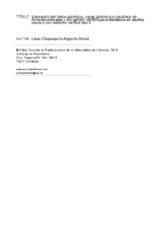Mostrar el registro sencillo del ítem
Valoración del índice glicémico, carga glicémica e insulínica de fórmulas enterales y con adición de fibra para diabéticos en adultos sanos y con diabetes mellitus tipo 2
| dc.contributor.advisor | López-Miranda, José | |
| dc.contributor.author | Angarita Dávila, Lisse Chiquinquira | |
| dc.date.accessioned | 2016-02-25T09:28:25Z | |
| dc.date.available | 2016-02-25T09:28:25Z | |
| dc.date.issued | 2016 | |
| dc.identifier.uri | http://hdl.handle.net/10396/13276 | |
| dc.description.abstract | Introducción: Recientemente, la Diabetes Mellitus se ha considerado un problema de salud pública a nivel mundial. Actualmente, en el tratamiento dietético, novedosos indicadores como el uso del índice glicémico (IG), y de la carga glicémica (CG), son útiles para predecir y reducir el impacto glicémico postprandial ante un determinado alimento. Debido a la gran variabilidad de la respuesta glicémica, se ha generado controversia con el uso de fórmulas enterales específicas con fructosa para diabéticos, en las que el (IG) y la (CG) aún no han sido ampliamente estudiados en Venezuela, concretamente en pacientes de este grupo. Por otro lado, el reciente interés hacia los componentes biológicamente activos de la linaza (Linum usitatissimum L.); y su potencial efecto hipoglicemiante, podría considerarse una alternativa útil en el área clínica y en la industria alimentaria para el diseño de fórmulas especializadas en el control glicémico. Objetivos: Valorar el índice glicémico y carga glicémica de fórmulas enterales específicas para Diabetes con distintos tipos de edulcorante y fibra dietética en adultos sanos y diabéticos tipo 2, y determinar si la incorporación de la fibra de linaza puede modificar el índice glicémico y la carga glicémica de una fórmula enteral con fructosa. Nuestra hipótesis propone que el índice glicémico y la carga glicémica de fórmulas nutricionales enterales edulcoradas con fructosa, puede ser modificado positivamente con una concentración de fibra derivada de la linaza (11 g, ≈ 40%); y una cantidad de fibra total en la fórmula de (3,33 g .100 ml), proporción que permitiría disminuir la respuesta glicémica e insulinémica post-prandial en adultos sanos y por consiguiente en sujetos diabéticos tipo 2. Diseño y metodología: Esta tesis se ha dividido en tres capítulos derivados de tres estudios: El primero, corresponde a un diseño controlado, aleatorizado y cruzado en 21 sujetos sanos, en quienes se determinó la respuesta glicémica e insulinémica a los carbohidratos que componen una fórmula edulcorada con fructosa (Glucerna SR®)(FN);para ello se utilizó el cálculo del incremento del área bajo la curva (IAUC) a través del método trapezoidal. En el segundo capítulo, se cuantificó y comparó el índice glicémico, y carga glicémica de dos fórmulas isoglucídicas Glucerna SR®)(FG) y (Enterex... | es_ES |
| dc.description.abstract | Introduction: Recently, diabetes mellitus has been considered a public health problema worldwide. Currently, the dietary treatment, novel indicators such as the use of the glycemic index (GI) and glycemic load (GL), are useful in predicting and reducing postprandial glycemic impact to a certain food. Due to the great variability of the glycemic response, it has generated controversy with the use of specific enteral formulas with paragraph fructose diabetics, where the (IG ) and ( CG ) have not been extensively studied in Venezuela , particularly in patients group.. On the other hand, the recent interest in the biologically active components of flaxseed (Linum usitatissimum L.); and its potential hypoglycemic effect, could be considered a useful alternative in the clinical area and in the food industry for the design of specialized formulas in glycemic control. Objectives: To evaluate the glycemic index and glycemic load of Diabetes specific enteral formulas for different types of dietary fiber sweetener and healthy adults and type 2 diabetics, and determine whether the incorporation of fiber flaxseed can alter the glycemic index and glycemic load an enteral formula with fructose. Our hypothesis propone that the glycemic index and the glycemic load of enteral nutritional formulas sweetened with fructose, can be changed positively with a concentration of fiber derived from flax (11 g, ≈ 40%); and an amount of total fiber in formula 3.33 g 100 ml), the proportion that would reduce postprandial glycemic and insulinemic response in healthy adults and therefore in type 2 diabetic subjects. Design and methodology: To this end, this thesis has been divided into three chapters / studies: The first controlled, randomized, crossover, and insulinemic determined glycemic response to carbohydrates that make up a formula sweetened with fructose (Glucerna SR ®) (FN) 21 healthy subjects, by calculating the incremental area under the curve (IAUC) through the trapezoidal method. In the second chapter, it was quantified and compared the glycemic index and glycemic load two formulas isoglucídicas Glucerna SR ®) (FG) and (Enterex Diabetic®) (FE) with different types of sweeteners and fiber 17 subjects (11 healthy and 6 with diabetes type 2) in a controlled, randomized, double-blind... | es_ES |
| dc.format.mimetype | application/pdf | es_ES |
| dc.language.iso | spa | es_ES |
| dc.publisher | Universidad de Córdoba, UCOPress | es_ES |
| dc.rights | https://creativecommons.org/licenses/by-nc-nd/4.0/ | es_ES |
| dc.subject | Índice glicémico (IC) | es_ES |
| dc.subject | Diabetes Mellitus tipo 2 | es_ES |
| dc.subject | Carga Glicémica (CG) | es_ES |
| dc.subject | Carga insulínica | es_ES |
| dc.subject | Fibra | es_ES |
| dc.subject | Linaza | es_ES |
| dc.title | Valoración del índice glicémico, carga glicémica e insulínica de fórmulas enterales y con adición de fibra para diabéticos en adultos sanos y con diabetes mellitus tipo 2 | es_ES |
| dc.type | info:eu-repo/semantics/doctoralThesis | es_ES |
| dc.rights.accessRights | info:eu-repo/semantics/openAccess | es_ES |

